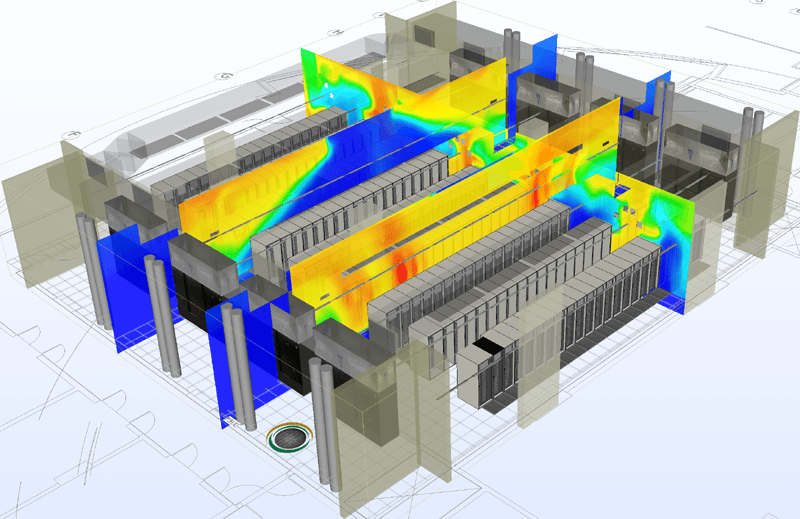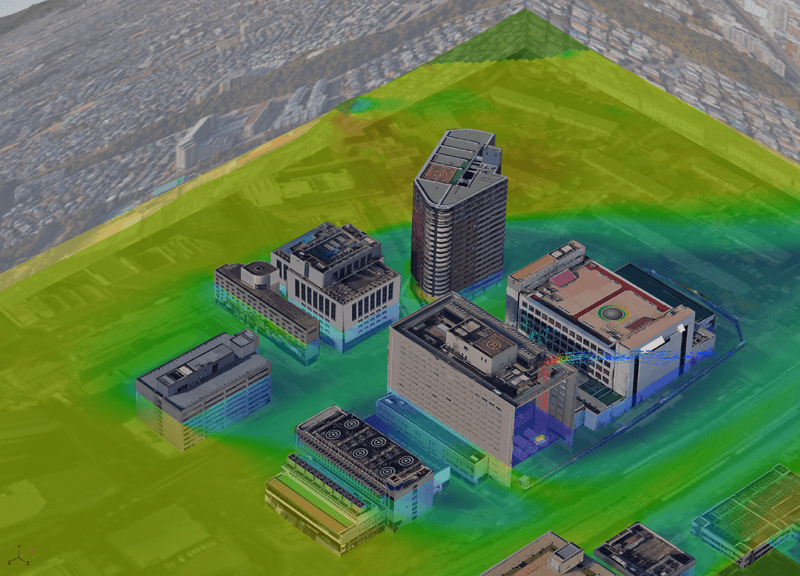On average, the insight that CFD provides our clients with existing data centers, results in reduced operating costs by 25%. (In extreme cases we have reduced electrical costs by over 50%). That typically means an ROI of less than 8 months.  Image 1 - CFD with temperature planes in the Hot and Cold aisles, and another cross-section temperature plane
Image 1 - CFD with temperature planes in the Hot and Cold aisles, and another cross-section temperature plane
What Else Does CFD Do For the Data Center
As we mentioned in the Case Study, there can be a lot wrong with the heat removal strategy. Room design, cooling unit arrangement, misunderstood ratings and “pretty” all contributed to the room failing to meet expectations on the initial commissioning and capacity maximums. It is a low cost way to know these problems exist through modeling before BUILDING the environment. And yes, even the cooling unit capacity issues for sensible versus total cooling capacity would have been discovered had they been modeled prior to. (We utilize the manufacturers’ specification to create the module capacity, complete with variable set points for cooling targets, and air flow). Hundreds of thousands of dollars can be cost avoided in both capital and operating expenses through low-cost CFD.
And Don't Forget External CFD
Utilizing the most advanced data center CFD modeling and simulation platform on the planet, GDCE also performs complex external CFD models. These may be used to assess heat planes, wind impact to crucial fire events (i.e. where will a fuel spill fire on a rooftop will lead to), airflow to heat exchangers and cooling towers, as well as architectural modeling, set against terrain contour for highly specific airflow patterns. There is nothing like science to validate a great strategy. External CFD provides further validation and information on where to place generators, heat exchangers, cooling towers, fuel tanks, generator plants, to name a few.
No Simulation Too big or Too Small - Our Competitive Pricing
GDCE has made it a goal to make CFD affordable to everyone. We offer a cost per kilowatt model for CFD modeling of $125USD per kW from 1kW to 30kW. Above 30kW we offer a fixed rate based on your data center rack size and kW to be utilized. (kW is based on either total IT load or total Cooling Capacity, whichever is greater… and we know that sounds counter intuitive, but we’ve seen plenty of cooling capacities not able to cover their IT loads).
This includes 4 scenarios for a single model. (Scenarios allow you to examine “What if this Cooling Unit isn’t available?” How does leaving the door open for long periods of time impact my data center? Will installing the raised floor at 600mm really give me an advantage over installing it at 300mm?
The choices of what scenarios you wish are yours, and we will work with you to determine what is most valuable to you. Additional scenarios can also be run at a cost of $25USD per kW up to 30kW, and negotiated for sizes higher at about %20 of the base cost. It will also include a highly detailed report of the results and analysis.
Image 2 - External CFD with velocity plane across the image, and Temperature Streamlines from Generator Plant  Contact Us About Your CFD Project
Contact Us About Your CFD Project
Let us provide a detailed scope of works for your CFD needs. Contact us, and we will discuss how we can reduce the cost of your data center, whether still on the design table, or already in operation.
The Case for CFD
For those who may be unfamiliar with CFD – Computational Fluid Dynamics – it is the science of modeling the movement of liquids or gasses and their interaction with obstacles and other influences. Utilizing CFD we can look at the three critical elements that make up the heat removal (and think heat removal, not COOLING): Air Pressure, Air Flow and Air Temperature. There is a lot of focus on Temperatures, and it may surprise many to find that of the three elements, Temperature is the least important. This is how many mistakes in setting up the heat removal from the data center occur.
It is no secret in the data center industry that if you want to reduce your energy costs, the first place to start looking is at the cooling. Cooling costs account for over 50 percent of a data center’s operating budget, and continues to grow as density rises and heat loads increase. Getting your cooling right is critical to not just controlling those costs, but also of reeling them in.
This is just as true for an existing data center as it is for one that is still on the design table. We have seen, many times, assumptions made about cooling. Is this scenario familiar?
Case Study (We have seen this scenario on more than one occasion)
You spent months designing the data center, and carefully calculating the loads. The cabinets have been designed with an expected distribution of 6 kilowatts per cabinet in your 100 rack space. That’s 600kW of heat load. Your UPS is nicely sized at 2(N+1) with 3 x 300 kVA UPSs on each feed. You have 8 Cooling units (CRAC/CRAH/PAC, etc.) at 90kW each, giving you N+1 capacity in your cooling.
Its commissioning day, and you crank up the load banks in the racks to a nice 6kW each… 600kW of heat is pouring into the room. Your cooling units are pouring cold air out at 22C (72F)… and in 10 minutes, the room temp is climbing out of control. After 12 minutes you start to reach temperatures of 33C (92F) at the top of the racks. Something is terribly, terribly wrong. Are the cooling units broken? Weren’t they Startup Tested properly? A check shows, they are working as expected.
You stop the test, the room’s getting too hot and everyone is sweating. If there had been real gear in the racks, it might have been a disaster. What is going wrong?
What’s Really Happening
An investigation reveals that the cooling unit provided by the vendor has a "total cooling capacity" of 90kW, but the actual sensible cooling load—which represents the effective cooling capacity—is significantly lower, at 79kW. This discrepancy arises due to the difference between outlet and return temperatures, in addition to heat generated by the unit itself, though this detail is not explored further here. The discovery that the real, usable cooling capacity is reduced to 79kW across 8 units results in an 88kW loss in cooling capacity, jeopardizing the expected redundancy as room temperatures rise.
To address these issues, Computational Fluid Dynamics (CFD) is employed to model the room, incorporating all critical factors affecting heat removal. This includes examining potential obstructions to supply and return air flow, analyzing the volume of air emitted by the cooling unit, its distribution path, movement speed under the floor, whether delivery is overhead, and the extent of cold and hot air mixing. The objective is to assess the severity of these factors and determine the actual capacity of the heat removal solution.
For this purpose, the advanced RoomDCX CFD modeling solution is utilized to create detailed models, regardless of complexity. This approach has proven its value, even in single rack environments, by significantly reducing operating costs and maintenance needs due to excessive wear and tear on poorly positioned components. No cooling unit will deliver it's "ideal capacity". But mistakes made that result in sub-optimal arrangement of equipment in rooms can be visualized and remedied before costly changes are implemented.
